Photo Illustration by Elena Scotti/Kotaku/GMG, photos via Chris Kohler, Shutterstock.
On a Sunday morning in September, Typhoon Talim was flooding the western part of Japan with a torrential downpour, but at Todoroki Station in Tokyo on the other end of the country, its effects were limited to a light rain.
A 20-minute ride south of the city’s famous Shibuya crossing, Todoroki is a sleepy residential station served by a single local train line. I got off the train at 9:30 a.m. and opened up my too-small cheap umbrella.
Face down in Google Maps, I passed by the small cluster of fast food eateries and convenience stores by the station turnstiles. The shops gave way to the sort of Tokyo you don’t see if you don’t leave its center: Trees. Winding roads. Gas stations. A garden full of massive leafy vegetables. A driving range.
The typhoon’s rains splashed my phone screen as I attempted to not get lost. This was not a town for tourists. There wouldn’t have been much reason for me to come to a place like Todoroki, but for this: Up the street is a collection that houses over 13,000 of Japan’s earliest computer games.
This is Ground Zero for a grassroots effort to preserve the origins of Japanese gaming history before they disappear.
Half a mile from the station on a quiet street, a gated, hedge-trimmed building houses a row of four-story units, rooms stacked one atop the other. One of these is the headquarters of the Game Preservation Society, a non-profit founded in 2011 with the goal of researching, documenting, and preserving the games of Japan.
Though most of its board members are Japanese, the society’s president and its main driving force is a French national, Joseph Redon. He lives here in the facility, and is the one who greeted me at the door as I put my plastic umbrella to the side and slipped off my shoes.
Redon, 41, cuts a striking figure: rail-thin in impeccably tailored clothing, his entire head bald including the eyebrows, spectacles with thin circular frames completing the mad-scientist look. He spoke with the quiet desperation of someone fighting a losing battle with time.
“In Japan, you don’t keep things,” he said.
“It’s a cultural difference, you see. Today, we have a typhoon. I felt an earthquake just a few minutes ago. You didn’t? Very small. But this country is a rock above the sea. It’s full of calamities.”
“The way of thinking, the way of living, the way things last, the cycle of their lives here is very different. You build a house in Japan, thirty years after, you need to destroy it and make a new one.”
This doesn’t bode well for the preservation of things like ageing computers and failing floppy disks. “In the 80s, during the economic bubble, people were buying a new computer, a new TV, every year,” he said.
“On top of that, we don’t have the room that you may have in America to keep everything.” Basically, Redon said, “almost nothing is left.”
And the situation with PCs is much different than game consoles like the Famicom, he says: if you pulled a Famicom out of the attic and plugged it in today, it would probably work. But if you discovered a PC-8801 and a pile of floppies today, odds are they wouldn’t boot right up, and you’d trash them. “You need technical knowledge,” he said. “But if it doesn’t work, people won’t keep it.”
Given this, Redon estimates that of all the copies of PC software that were sold in the 80s, 99 per cent of them have already been destroyed. The remaining one per cent is what the society is fighting to save from the ravages of time.
In America, it was the Apple II. In Britain, the ZX Spectrum. And in Japan, the PC-88.
Before the planet coalesced around the IBM-compatible, Windows-based standard, it was a world of diverse, regional, wholly incompatible personal computers. While Japan had a number of different competing formats in the 1980s including the Sharp X1 and the Fujitsu Micro 7, it was NEC’s PC-88 series that dominated.
Many Japanese game publishers got their start making PC-88 games: Square, Enix, Koei, Falcom. Hideo Kojima’s Snatcher was originally a PC-8801 game.
The machine even had its own licensed versions of Nintendo games like Super Mario Bros.
While the Game Preservation Society’s Tokyo headquarters houses games from all Japanese PC formats, it’s the PC-88 series, “the most emblematic of PCs in Japan,” that Joseph Redon is most focused on. While he estimates that the society has about 60 to 70 per cent of PC-88 games, he notes that finding undiscovered games is extremely difficult today.
“With luck, and with a huge effort, maybe 80 per cent is the maximum we can get. If 80 per cent of PC-88 games are preserved for the future, it’s even more than was preserved for films,” he said. “So it’s a great figure.”
Even so, the idea that 20 per cent of games that were made in the 1980s might be lost forever is a bitter pill to swallow.
Joseph Redon with the Society’s library of vintage PC gaming magazines.
As we passed through the entranceway of the apartment, we squeezed by a row of stacked banker’s boxes full of Japanese PC games. I opened a box and saw a plethora of games: Ultima VI, in translation. Moon Ball, a pinball game. Legend of Galactic Heroes III SP.
This was all temporary, Redon explained, and noted that if I had come a year earlier I would have seen over three hundred of these boxes filling up rooms in the apartment. This relatively small row was what’s left after everything had been processed and archived, upstairs, where we headed next.
Of the 13,000 games stored at the headquarters, 8,000 are unique titles. It’s important to have multiple copies of the same game for many reasons, Redon said, not least of which is that the seemingly-identical disks might hold different versions of the software.
Many of these extra copies come from buying bulk lots of games on Yahoo Auctions or the like, which usually include some of the mega-sellers of the time, like the inaugural entries in still-popular RPG series like Ys or Legend of Heroes.
If you were to climb up these stairs expecting to see shelves of brightly-coloured game cases arrayed like the world’s biggest retro game store ripe for the picking, you’d be disappointed. Instead, the second floor houses rows upon rows of identical, numbered boxes.
“Every single part of the game is kept in a different room,” Redon explained. The floppy disks, cassette tapes, and other magnetic media that store the games are highly volatile and susceptible to mould. So these are placed separately into custom-built, acid-free storage boxes and put in a climate-controlled room that is carefully monitored for temperature and humidity.
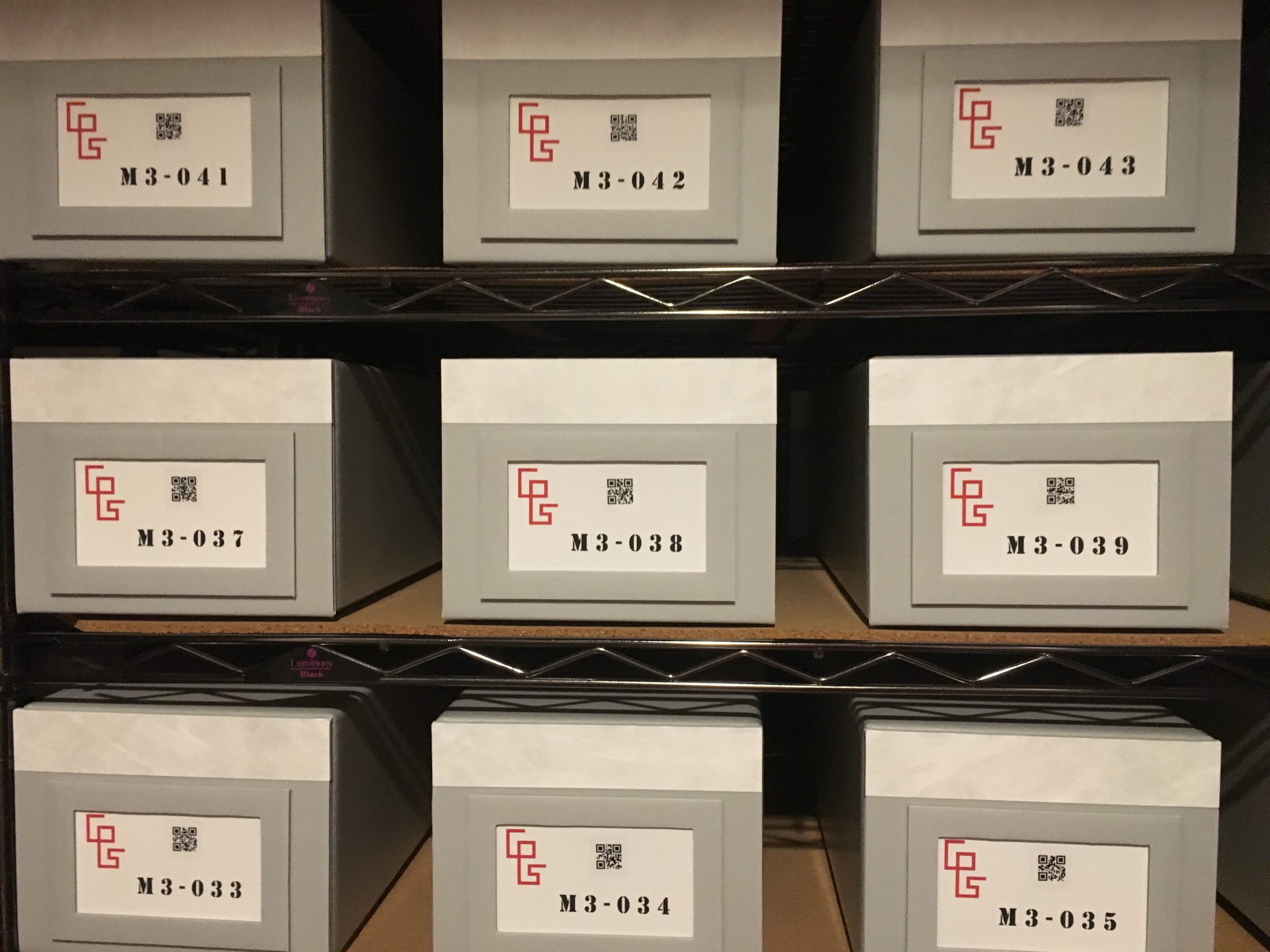
Boxes of floppy disks at the Game Preservation Society.
The cardboard boxes the games come in are stored in larger boxes off to the side, and the manuals are placed in custom-sized, acid-free envelopes on a large metal shelf in the hallway. If a game originally came in a plastic case with a paper cover insert, the insert is removed (otherwise, humidity might cause it to stick to the plastic and be destroyed) and stored in a massive art portfolio.
When the society processes a game, it first enters it into its database, then tags each piece with a QR code. When Redon wants to reassemble a game (for a photo shoot, for example), he can then locate all the pieces easily.
All of the containers are of the absolute finest quality that the Society could source. The cassette tapes are kept in acid-free plastic cases made in the U.S. Redon ships them in by the thousand. “Archival of cassette tapes, records, et cetera is more advanced in the United States than any other country,” he says.
The envelopes, though, are made in Japan — when it comes to paper, Redon said, Japan has no equal. The boxes are made by a company called Shiryō Hozon Kizai, which provides archival solutions to libraries and museums in Japan.
It had never worked with games, so it was interested to partner with the Society to get in early on what it thought might be a bigger business later, once more people and institutions in Japan come around to the idea of archiving its gaming history. If they do.
The day before, I’d just bought something in Akihabara, Tokyo’s gaming district, that I thought Redon would appreciate: I’d been piecing together a collection of Square’s early computer games, the ones that predate the original Final Fantasy, and the day prior I had finally found a copy of its very first game, a 1984 PC-8801 adventure game called The Death Trap.
I showed Redon the photo on my phone. “Oh, yes,” he said, “the second edition.” Oh no, I thought, figuring I’d shelled out for a later printing that wasn’t the first first game. “The first version of The Death Trap,” he said, “was very very difficult to find.”
In 15 years of searching for the game, he’d seen just two copies of the first print.
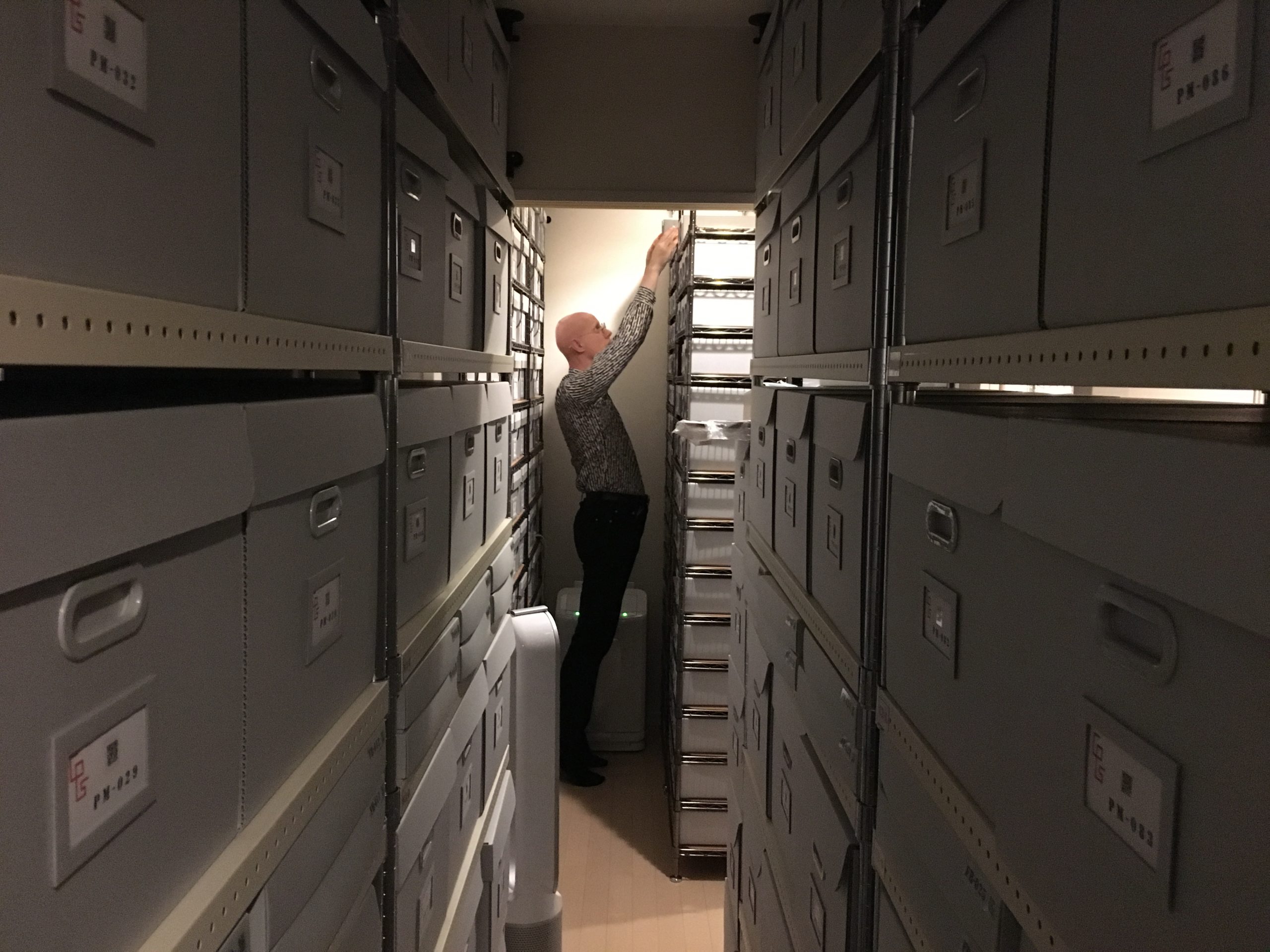
Redon locates a game in the Society’s archives.
Suddenly, I felt a lot better about owning my second printing. I felt even better than that when we started flipping through 1980s PC gaming magazines, a complete collection of which is housed on the HQ’s first floor.
We found that second-edition cover of The Death Trap pictured in a 1984 magazine, meaning that it was released during the same year as the original and wasn’t a later reproduction.
This is the sort of knowledge that can get lost far more easily than the games themselves.
“You cannot talk about Death Trap if you only have it working on an emulator. That’s not history,” Redon said. “You were looking at a magazine, that’s part of the essence of the game… We’re trying to gather everything around a single title so people can access this stuff and talk about this art with a new eye.”
“If it’s preserved, and if it’s accessible to the public, I hope writers, researchers, and historians will find those little gems, talk about it, and rewrite history,” he said. The history of games that’s commonly spread around — in the beginning, there was Space Invaders, which begat Pac-Man, which begat Mario — might be the history of the most successful products, but it’s not the history of the most influential art.
“When you’re talking about art, you forget that it sold one million copies,” he says. “The history of video games that I’m reading every day on the internet everywhere is not the history I know. And is not the history as it was back in time.”
Joseph Redon was 16 when he first came to Japan, in 1992. His dad helped finance the trip, but he travelled alone. His aim was simple: Buy games for the PC Engine.
Like most Western game fans of the time, Redon had never heard of the PC-88. But he was obsessed with the Japanese gaming console known as the PC Engine, released in the U.S. as the TurboGrafx-16 and not released in Europe.
“In France at that time, even a second-hand PC Engine game was full price. Very expensive,” he said. So he figured he could save a bit of money by travelling to Akihabara and buying used games in Japan, where the PC Engine was still on the market and quite popular.
He figured that with the money he had saved, he could buy maybe 10 or 15 PC Engine games. “But I found the games I was looking for and they were only 100 yen, 200 yen,” he said — literal pocket change. He came back with 150 games in his suitcase.
Redon quickly made up his mind: he needed to live in Japan. But this wasn’t going to happen any time soon. In the meantime, he built up his game collection, keeping everything in mint condition. He’d had Commodore 64 games when he was younger, but lost them all, and couldn’t play them again. He wasn’t going to let that happen with his PC Engine games, no way.
PC-8801 (left) and Panasonic MSX computer systems at Beep, a store in Akihabara.
In a stroke of luck, while still living in Paris in the late 90s, Redon bought a PC-98 (an upgraded model of the PC-88 line) from a Japanese couple who were living there. By then, he’d seen Japanese PC games in Akihabara shops and realised that these were the original, the real versions of games he enjoyed on the PC Engine.
A Japanese friend on the early Internet chat service ICQ supplied him with a copy of Sorcerian, another early Falcom RPG, and now Redon could play the game in its original form, on a real Japanese PC.
This worked for exactly three days.
Seventy-two hours after he booted up the PC-98, something went wrong, and the power supply got fried. It was unrepairable, and irreplaceable. “I was so sad, I cried,” Redon said. “I tried everything to reach this world, but now it disappears in front of me.” That was the last straw. “In 2000, I decided to leave everything — apartment, cats, girlfriend, family, job — and with my last paycheck, I moved to Japan.”
At first, Redon just gorged himself on games, learning about the secret world of Japanese computers and making friends in the hobby. In 2006, a friend who’d written a book about the PC-88 wanted to sell his 1,000-game collection.
“He had travelled all across Japan to computer shops, and bought them for very cheap prices,” Redon said. The friend would offer the shop owner the equivalent of a hundred bucks or so for all the PC-88 games in the store, then have them all shipped back to his home. Redon bought the collection, which became the beginning of the Game Preservation Society’s archive.
Around the same time, Redon began to worry about preservation. He had these games now, but what about 10 years from now? They’d go the way of his childhood Commodore collection unless something was done about it.
The word “remaster” is used a lot in today’s video game industry, mostly incorrectly. A developer takes a PlayStation 2 game, upscales the resolution, redraws the textures, has a live orchestra redub the soundtrack, and re-releases it on PlayStation 4.
This is called a “remaster,” but it’s not. What Redon and the rest of the Game Preservation Society do every day is remastering in the real sense of the word — starting with lossy, degraded copies, they painstakingly work their way back to creating a new master version of the game, a perfect preservation from which more copies can be made. If one had that, it wouldn’t matter if the original floppy disks got moldy and died.
This is much more complex than simply copying a floppy disk or a cassette tape. Of course, today you can visit the Internet Archive and find hundreds if not thousands of PC-88 games that you can download and play via an emulator on your modern-day PC.
But these are bootlegs, not remasters. For starters, the disk may have had copy protection that whoever “dumped” the game data might have had to circumvent. The game code might have been tweaked to get it to boot up on the emulator.
And the emulator itself isn’t a perfect recreation of the original. If you want to be able to make new copies of a game that will play on an original PC-8801, you need to copy the disks themselves.
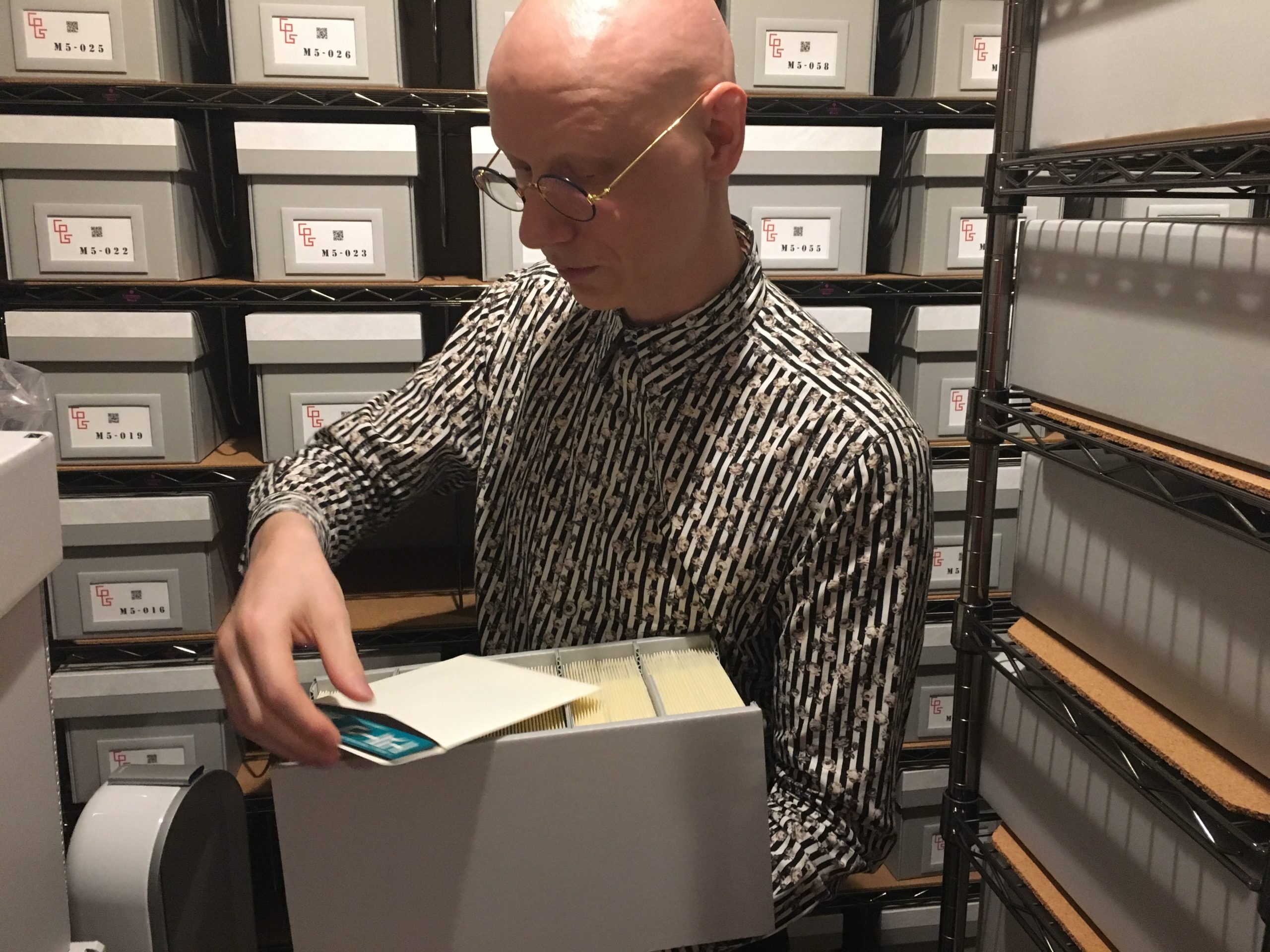
Each element of a game is tagged with a QR code and stored separately in acid-free, specially-designed envelopes and boxes.
But even this is not something that computers are set up to do. A floppy disk or cassette doesn’t actually have ones and zeroes printed on it. The data is stored by altering the magnetic flux on the media. A computer has a floppy disk controller, a piece of hardware that translates these magnetic variations into computer code.
But the floppy disk controller only reads some of the disk, the part it thinks you want to see. It will write that code to a new disk, retranslating the code back into a magnetic signal — but at that point, it’s more like a Xerox, not a new master copy.
Through his research, Redon discovered that a group in Europe called the Software Preservation Society was tackling this same problem while trying to preserve all the games for the Commodore Amiga computer. It was founded by an Amiga game programmer who had wanted to play one of his old games, but only found cracked versions, where the hacker who had broken the copy protection had placed his own demo reel in front of the game. “It’s like graffiti on your work, for him,” Redon said.
The programmer was able to figure out a way to get the Amiga to just read the signal off of the disk, skipping the part where the floppy disk controller analyses it. “From there, he made a new master. From this new master, he can write a perfect copy of the original,” Redon said.
Redon wanted to work with this group, but for a while, they were uninterested in branching out beyond the Amiga. Once they decided to expand the project, they began to help Redon with his PC-88 work.
They quickly discovered that a software solution was not going to happen, and that they needed to develop a special piece of hardware to read the magnetic signal on PC-88 and other disks.
Their research and work resulted in the KryoFlux, a USB device (that anyone can purchase) which reads and writes the signal of any magnetic media at a low level, allowing perfect copies to be made even if one doesn’t own the original computer.
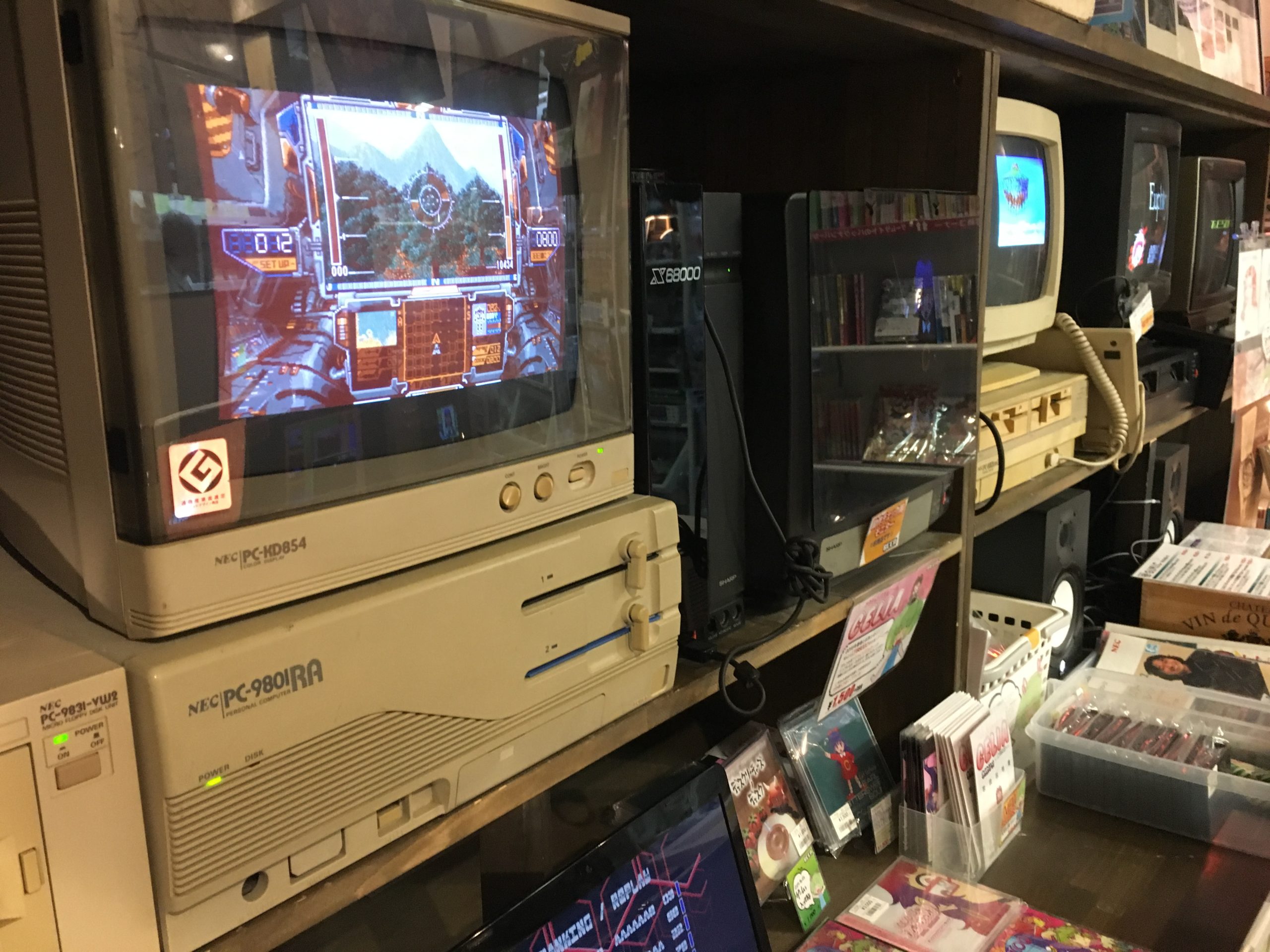
More models of Japanese PC on display at Beep.
“When we have a remastered copy of the game, it works the same way in the real machine as if we were using the floppy disk,” Redon says. “We’re not working on emulations today. We want the stuff to work on the real hardware.”
Redon likens the experience to classic cars: “You don’t want to replace the engine. You want to have the same feeling people had at that time when they were driving. You clean everything. If there is something broken, you will change only that part. I think we can do the same thing with computers. If the processor breaks, we will have the technology to replace it if we have enough information.”
Even being able to read the magnetic signal directly off of PC-88 disks doesn’t solve all the problems, though, due to the way that Japan’s computer game industry evolved. Western game publishers had high standards and expensive custom equipment to duplicate floppy disks. But Japanese gamemakers were using lower-tech solutions.
“They were duplicating games like you duplicate a cassette tape in a double deck,” Redon says. “It was fully analogue.” And the issue with this for the Society is that it’s impossible to tell if a game was modified after the fact, which often happens.
Early computers didn’t have hard drives. The game ran directly off the floppy, and the computer would write data — saved games, user names, high scores — directly to that floppy. If one examined a disk with the KryoFlux, one could easily tell which magnetic signals were laid down with a high-quality digital mastering device (the original game as it was shipped), and which parts of the signal were added later with a home floppy drive (a user’s alterations).
But with Japanese games, even ones from the major publishers, it all looks homemade and loose. There’s no way to just look and be able to tell what’s part of the game, and what was written later.
A game, as Redon often points out, is not just a disk image. It’s also all the related material, the box, the manual, the maps, the catalogues, the magazines. The first floor of the headquarters, where an entire wall of bookshelves holds what has got to be the world’s largest and most complete collection of Japanese PC gaming magazines, is where the rest of the remastering happens.
A massive state-of-the-art PC sits there, opposite the bookshelves, with an equally massive flatbed scanner attached to it. The room can be darkened and the monitor, with shades all around it, specially lit, so colours can be seen perfectly.
Everything Redon scans, he scans alongside a piece of cardboard with Kodak Colour Control Patches printed on it, so that the image can then be perfectly colour-corrected. Then he painstakingly uses Photoshop and other programs to digitally retouch the boxes, then make new digital master versions that could be printed and folded to make a new box.
Panorama Island is one of the most historically significant games in the Game Preservation Society’s archive — the first RPG ever made by Falcom, which would go on to create Ys and Legend of Heroes. It’s also incredibly rare, and the only copy in the Society’s archive is in poor condition.
Redon scans the image, taking pains to make sure the colours are accurate and the original artwork is captured in all its detail.
He then digitally retouches the image, recreating the box art where the original has been worn away.
This sheet of colour swatches is directly from the same printing facility that produced most classic game boxes of the era, Redon said. He can scan this alongside the original boxes so as to match the original colours perfectly.
The final product is a true “remaster” of the original box; Redon could send these files to a printer and have a perfect reproduction made.
But Redon has gone even further than that. He pulls out another piece of cardboard with swatches of colour glued to it. This, he says, is from the printer that handled most of the original game boxes back in the 1980s. He had them go back and find the exact colours and types of ink that were used to print these boxes. So now he could send his remastered files to this printer and have them create a box that is exactly like the originals. He’s actually done this, once, for an exhibition in Japan that wanted to display a replica of Love Match Tennis, the first game created by the eventual designer of Dragon Quest, Yuji Horii. It looked perfect.
Although Tokyo is the Game Preservation Society’s headquarters and Joseph Redon its president, he’s far from the only one spearheading the project. And although the HQ is full of PC games, the society preserves console and arcade games as well.
Another branch of the society is in Niigata, Japan, under the care of the society’s vice president Takuya Fukuda. Redon met him after he published an article in Japanese detailing the KryoFlux; Fukuda messaged him “instantly” telling him that he was about to create the same piece of hardware, and he’d just saved him months, maybe years of research.
Fukuda, a cardiac surgeon, was a hardware hacker in his spare time, creating machines to preserve Nintendo’s Famicom Disk System games and more.
“He’s the one who told me: With this technology, we can do great things. Let’s be official.”
The entrance of Beep Shop in Akihabara, Tokyo.
The third original member of the society was Masakuni Kobayashi, the head of Beep, a mail-order store for computer games and PCs based in Saitama, Japan. Beep also recently opened a brick-and-mortar store in Akihabara, and it’s one of the only public spaces in Japan where you can go to see the world of vintage Japanese computers brought to life.
A tiny basement shop at the bottom of a long flight of stairs, Beep has just a few tiny aisles into which two decades’ worth of history is crammed. One wall has a PC-8801 and a Sharp X1, fully functional and playing demo modes of game software right off the floppies.
On the other side of the store, there’s a glass showcase in an aisle that you basically have to turn sideways to navigate, full of incredibly rare PC games, many of which cost far more than the rare console games elsewhere in Akihabara. This is the showcase from which I plucked The Death Trap the day prior.
Galactic Wars I, the first game ever made by Falcom, can be purchased there for about $US4,000 ($5,109). Redon has a copy, too; it took him 15 years to find and he paid about that much.
Each copy of Galactic Wars I was made by hand, to order, at a game shop run by Falcom in the 80s. In the showcase at Beep, it sits next to pornographic games made by Koei, which would go on to create the Dynasty Warriors series, with titles like The Seduction of the Condominium Wives and Do Sex Dolls Dream Of Electric Eels?
Rounding out the society’s board of directors is Naoki Horii, the president of the game development studio M2. That’s the group that specialises in emulating classic games for modern machines, such as the Sega Ages collections, the Game Boy Advance games on Wii U’s Virtual Console, and the recent Seiken Densetsu collection for Switch.
So the Society has deep links into all facets of the gaming culture of Japan, from retail to development to fan circles. Another 14 “core members” volunteer with the organisation.
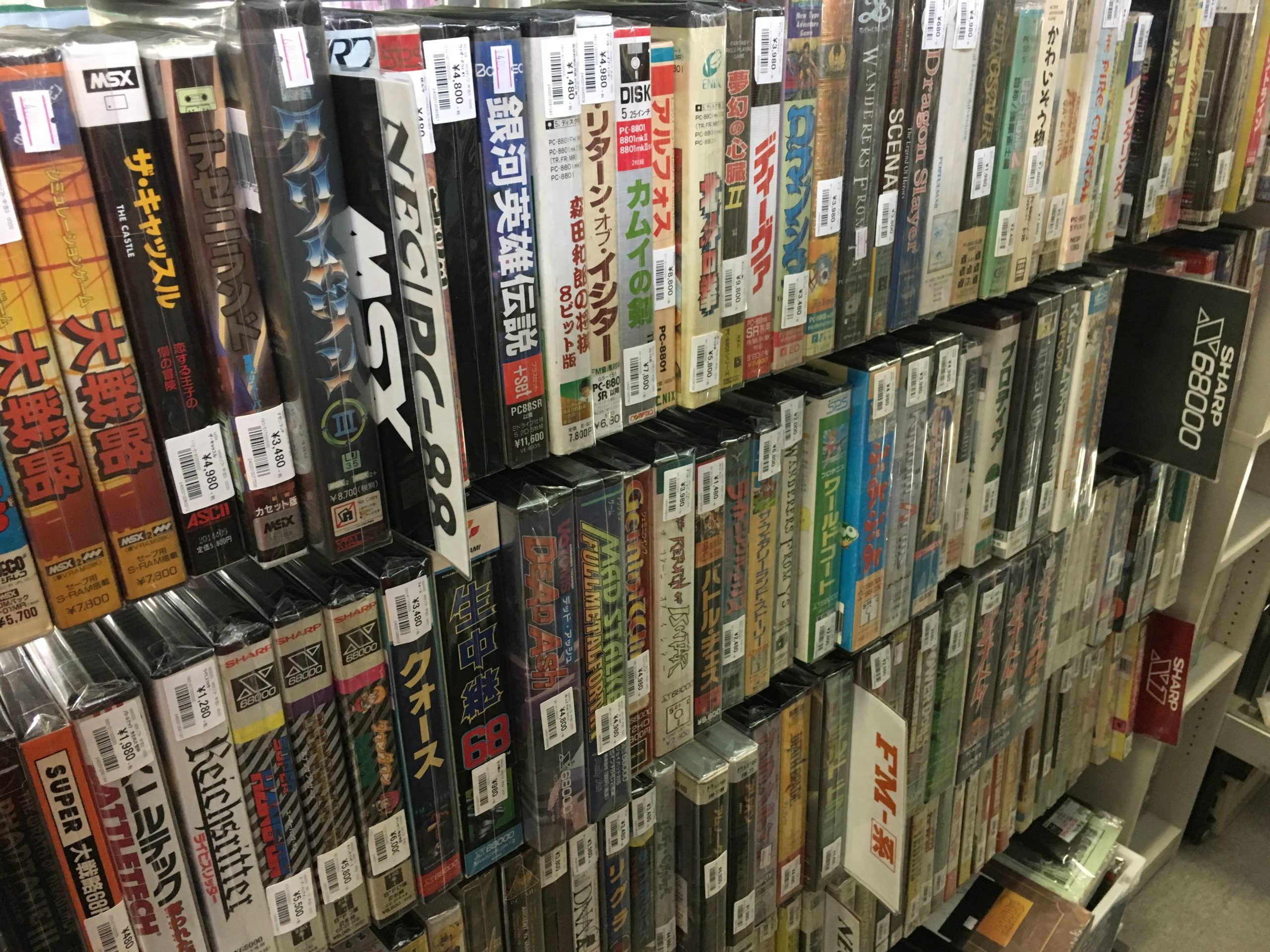
Pricey vintage PC games line the shelves at Beep in Akihabara, separated by format and neatly wrapped in plastic.
There’s even a secret location somewhere in Nagoya where one of those members has stashed what Redon believes to be “the most amazing Japanese console collection in the world.” Around the year 2000, this anonymous collector decided he wanted to buy every video game.
So besides going back and completing collections of console games released prior to 2000, he started buying every game produced in Japan, on the day of its release. And he hasn’t stopped.
“He’s still, today, buying games every day, as they are released, for every system,” Redon says. “He did it real-time… not only games, but also hardware.”
“He wanted to spend the rest of his life, after he quit his job, playing video games.”
“We are not game collectors,” Redon said. Game collecting is a competition, but archiving is a group effort. Redon mentioned the Video Game History Foundation, a similar non-profit recently formed here in the U.S. by my friend Frank Cifaldi. “There are only a few people like me and Frank doing the job today. For me, it’s a team. We are all working together.”
Game collectors, Redon said, do see the Society as competition. Any game that goes into the archive is one they can’t have in their own collection at home, and collectors are often loathe to share their finds with the archive. “This is the main reason I started my own collection of PC-88 games,” he said, “because I understood that even if we have a great project, we have the technology, we have everything, it will be very hard to get collectors involved.”
The Game Preservation Society would love to start widely sharing its work with the world. But it’s hamstrung by Japanese copyright laws, which Redon said are much more stringent than America’s and don’t carve out exemptions that let non-profit research organisations make copies of copyrighted material elsewhere.
The law is on Frank Cifaldi’s side in a way that Japan’s is not on his. Unless the situation on the ground changes, the Society will be working to preserve the games in relative privacy until they run out their term of copyright in, oh, fifty years or so.
Redon files away game manuals in a carefully climate-controlled storage room.
In the meantime, it’s hoping to convince the powers that be that preserving Japan’s video games is of utmost importance. It’s been an uphill battle, but Redon says the society has now secured its first government grant: Beginning in October 2017, it will be funded to work 1,200 hours on creating an official, publicly available catalogue of PC-88 software, which will become available next year. “This is something we couldn’t do without funds,” Redon says. “It’s a good start. It’s heading a good way.”
But funding is still Redon’s most pressing issue.
The Game Preservation Society’s efforts have earned it some good press over the years, most notably a half-hour documentary that aired on NHK World, the international channel of Japan’s sole public broadcasting network.
It was a slickly produced piece that followed Redon around Japan as he met with the other Society members, with interstitial pixel-art animated sequences created by the designer of Cave Story. Prior to the documentary’s airing, the Society had about 20 “supporting members” who did not volunteer, but simply paid about $US25 ($32) a year to support its work. After the documentary, it had 200 supporting members.
This is not nearly enough, Redon said. No one draws a salary from the Game Preservation Society. Redon estimates 90 per cent of the money goes directly into projects, with just 10 per cent for overhead costs.
The board members of the Society don’t seem to lack for spare cash to spend on their personal projects. Redon is a network engineer at a major Japanese car maker, Fukuda is a cardiac surgeon, Horii and Kobayashi own thriving businesses.
So far, Redon estimates that they have spent one million dollars total on everything. Over half a million of that, he said, was spent acquiring PC games in today’s ruthless, competitive collector’s market. The rest was for rent, utilities, those acid-free custom cases, and everything else.
Often, society members will invest their personal funds into personal projects, but they can’t scale these things up within the group even though they have the funds in their own bank accounts. “We have the physical archive,” Redon said. “We have the database, we have the knowledge. We have the materials, the documents, magazines, et cetera. We have proof of concept of how to preserve every single material — games, floppy disks, magazines, etc.”
But Japanese rules for NPOs state that the majority of the money spent must come from public donations, government grants, and the like, he explained. So the board of directors can’t simply put their own money into the NPO, as they could in the US.
In other words, Redon feels that all that great press, all those beautiful-looking videos, might be giving off the wrong impression — the impression that everything is humming along perfectly. In reality, there’s not enough money to save the games.
On the second floor of the headquarters is another work station, this one for dealing with vintage electronics. The desk is piled with equipment, but tidily arranged and impeccably clean. There are stacks of floppy drives in various sizes, a machine that erases EPROM memory chips, a desoldering station, a dual-deck cassette player, and a wide array of speciality cleaning solutions for all manner of electronic parts.
And in the centre of it all, in a place of prominence, sits Redon’s first love: the PC Engine.
While this facility is devoted to computer games, Redon just can’t resist having some PC Engine stuff to work on as well. The machine was ahead of its time: Released in 1987 in Japan, it was also the first game console to have a CD-ROM add-on, which was released in 1988.
This is well before the average PC consumer even dreamed of adding a CD-ROM to their rig. The first two games released for the PC Engine CD-ROM — Fighting Street, aka the original Street Fighter, and a dating game called NoRiKo — were the first two CD games ever, on any platform.
The fact that the PC Engine CD-ROM was released so early in the lifecycle of the medium means that it doesn’t follow today’s accepted industry standards, because it predates those standards.
“It’s basically an audio CD,” he says. “It’s data in audio.”
Rather than use a Table of Contents, like most CDs, at the beginning of the disc to tell the drive where information is located on the CD, the PC Engine has “subcode” located throughout the entire disc that tells the drive, in real time, where it is.
“This is why, for example, when you’re playing PC Engine games, if you touch the console, you lose the music,” he says. If you knock the laser out of alignment, it doesn’t know where to go. “It’s not capable. It’s like a stream. If you break the stream, you break everything.”
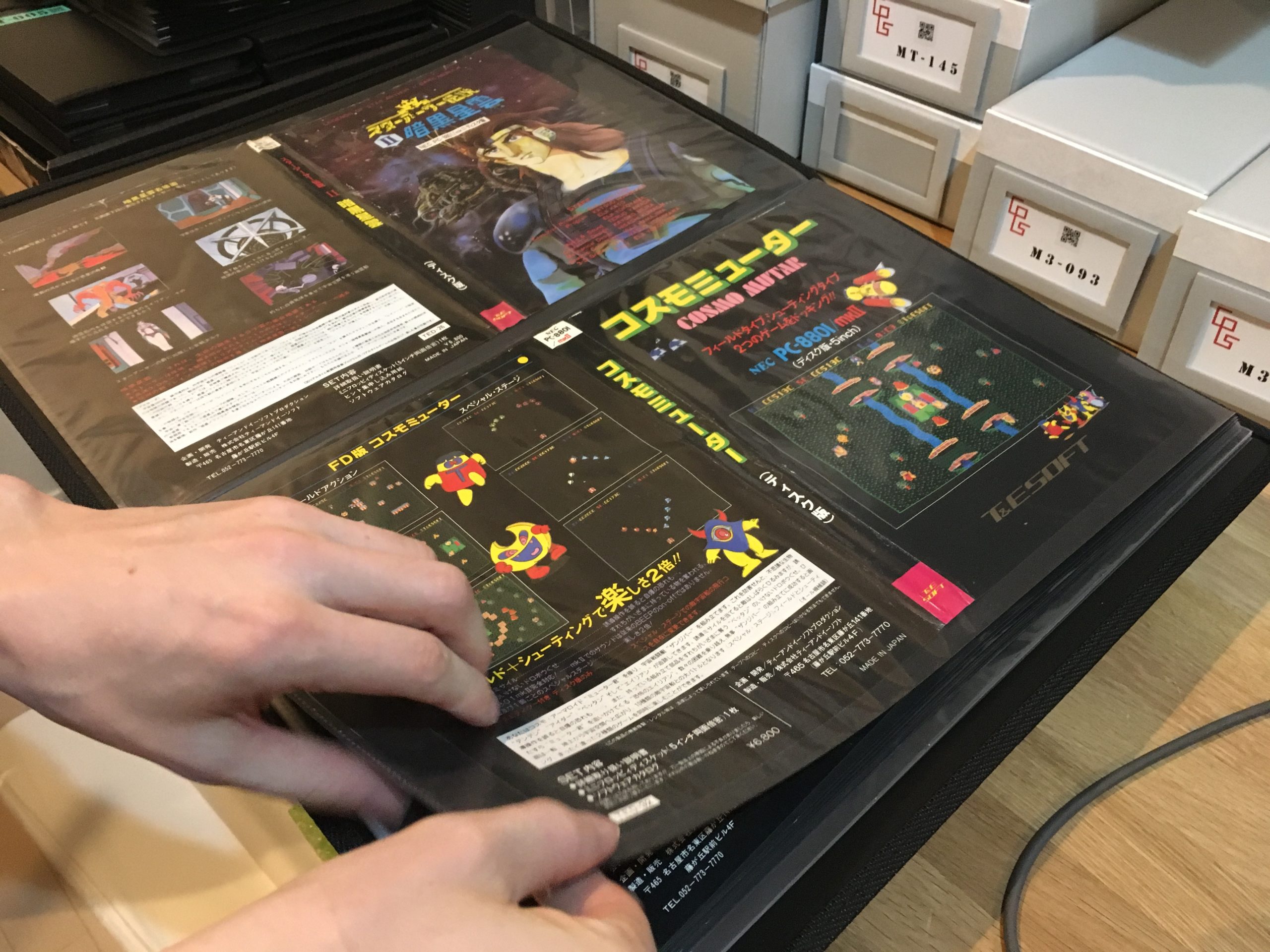
Game slipcovers are stored in artwork portfolios.
Like PC-88 games, the vast majority of PC Engine CD games have been “dumped” by fans using home equipment, so they can run on emulators. But that’s not remastering. “We have the technology at the Game Preservation Society to make a perfect reading of all the information we have, to resynchronise all of this,” Redon says.
So only now can they dream of making perfect copies of PC Engine CD-ROM games that run on a machine exactly the way the originals did.
Before it’s too late.
Those of us who grew up with floppy disks understand that they are volatile material. They’re magnets, for crying out loud. I might erase my copy of The Death Trap if I bring it too close to the fridge. But CDs look stable. A CD that I kept in its original packaging looks just as bright and shiny as the day it was pressed. Surely this isn’t in danger of failing any time soon?
“You think that your CD is clean. It’s never. It’s never,” Redon says. All CDs, from the moment they are pressed, have some errors simply due to the way they’re made, he said. But there’s enough redundancy built in that a CD can still be read even if 20 per cent of it has physical errors. “Past that, the algorithm to recover won’t work. It will stop reading everything.”
The standard for a CD manufactured today, he said, is less than one per cent of errors when it comes off the line. But at the time the PC Engine discs were made, there was no standard. Redon says that newly-made PC Engine discs had around five per cent error on day one.
And it’s getting worse. When the Society first started doing low-level analysis of PC Engine CD data a few years back, the discs they were using were already showing a six or seven per cent error rate.
Today, when they check the same discs, the error rate is more like nine or 10 per cent, he said. The CD-ROMs are dying, and they’re dying fast. It’s likely that there will be a moment, in our lifetimes, when reading most PC Engine discs will become simply impossible. When that rolls around, Redon hopes that remasters will be available for everything. Collectors may weep many a tear that day over the death of their valuable treasures, but from a true preservation standpoint, it won’t matter.
“We still have time,” he says. “But … it should be done quickly.”
Comments
One response to “Saving Japan’s Games”
Doing god’s work.